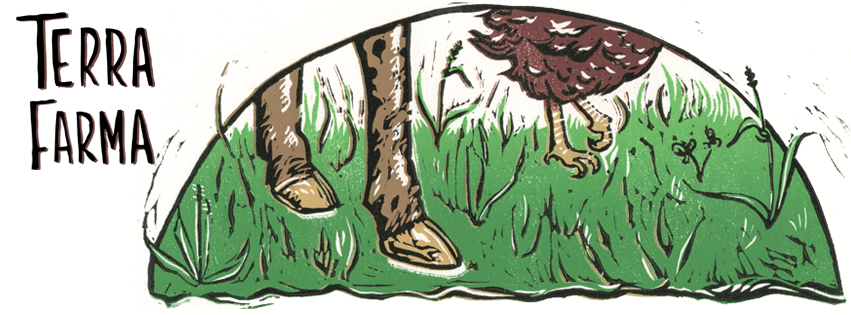In your share
- Rabbit
- Chuck roast
- Ground beef
- Bacon
- French garlic sausage
- Ground lamb
Membership update
Next month marks the end of the fall season, and for those of you who signed up a year ago for the entire 2023 calendar year, it’s also time for you to renew. We are offering the full-year option again, which will save you $85 over renewing each season, plus you will be protected from any potential price increases throughout the year. Here’s the link to our store: https://terra-farma.square.site/
On the Farm
November is always a time of transition as we move towards the slower months with far fewer animals on the farm than in the busy days of summer. The last of our broiler chickens was processed in late October, our hogs went in for processing on Halloween, and as of this writing, the turkeys will only be here for a few more days. For all our grazing animals – cattle, goats, and sheep – by this time of year we normally have them in their winter paddock, which we call a sacrifice area since the grass goes dormant in the winter and their diet mostly consists of purchased hay. But this is where our dedication to regenerative agriculture for the past 20 years is paying off, as our dedication to improving soil health through the carefully managed movement of livestock across the landscape is creating conditions where our pastures are still actively growing, and we are still giving the animals new forage to graze on each day. This not only helps us save precious financial resources by reducing the amount of hay we need to buy, but whenever grasslands are in their growth phase they are photosynthesizing, pulling carbon dioxide out of the air and storing a significant portion of it in the soil. You may have seen recent news reports about a carbon capture plant that is about to come online, one that aims to pull carbon dioxide out of the atmosphere and store it in powdered limestone. Not only is this process potentially energy-intensive, but it is also expensive, requiring taxpayer dollars to operate, and produces no real usable product. On the other hand, systems like ours that work in harmony with natural systems achieve the same result but also provide nutrient-rich food with little in the way of energy inputs. Imagine the potential if we restored all the corn and soy monocrops throughout the Midwest with native prairie and grazing animals!
If you want to read more about how we graze for soil health, check out this article I wrote for the Oregon Pasture Network: https://oregonpasturenetwork.org/2023/07/10/a-tale-of-four-pastures/
Recipe
Quick Lamb Ragu from “NYT Cooking” by Alison Roman
Ingredients
- 2 tablespoons olive oil, plus more for drizzling
- 1 medium yellow onion, finely chopped
- 4 garlic cloves, finely chopped
- Kosher salt and black pepper
- Pinch of red-pepper flakes (optional)
- 2 anchovy fillets (optional)
- 2 tablespoons tomato paste
- 1 pound ground lamb
- 1 (28-ounce) can crushed tomatoes
- 12 ounces cooked pasta, noodles or tubes, for serving
- A good hunk of Parmesan or pecorino, for serving
- A small handful of marjoram, oregano, or thyme, for serving (optional)
Directions
- Heat 2 tablespoons olive oil in a large Dutch oven or heavy-bottomed pot over medium heat. Add onions and garlic, and season with salt and pepper. Cook, stirring occasionally, until the onions have become translucent and have totally softened, 5 to 8 minutes. Add a pinch of red-pepper flakes and anchovies, if using, and cook for a minute or two, just to toast the spices and melt the anchovies.
- Add tomato paste and continue to cook, stirring occasionally so it has a chance to stick to the bottom of the pot and caramelize a bit, 2 or 3 minutes.
- Add lamb and season with salt and pepper. Using a wooden spoon or a spatula, stir lamb until the fat starts to soften and the meat begins to break down. Continue to cook, stirring rather frequently until the lamb begins to brown and sizzle in its own fat, 5 to 8 minutes.
- Add crushed tomatoes, stirring to scrape up any bits on the bottom of the pot. Fill the tomato can halfway with water and swirl around to get all the remaining tomato, then add to the pot. Season with salt and pepper and bring to a simmer. Reduce heat to medium-low and continue to cook until sauce is thickened and insanely flavorful, 25 to 30 minutes.
- Serve sauce mixed into and over pasta with plenty of cheese for grating over the top, scattered with a small handful of marjoram, oregano or thyme leaves if you like.
Bonus recipe
I’m just giving you a link for this one, since I’m out of space, but since we don’t include rabbit very often, we wanted to include a preparation idea: https://www.krumpli.co.uk/rabbit-stew/
